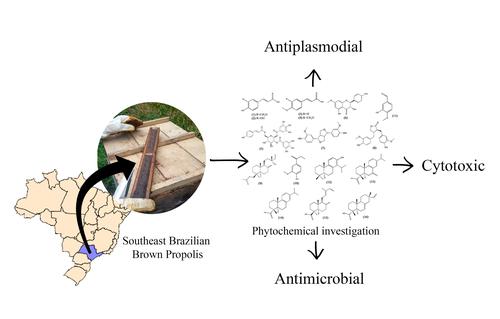当前位置:
X-MOL 学术
›
Chem. Biodivers.
›
论文详情
Our official English website, www.x-mol.net, welcomes your
feedback! (Note: you will need to create a separate account there.)
Phytochemical, Antiplasmodial, Cytotoxic and Antimicrobial Evaluation of a Southeast Brazilian Brown Propolis Produced by Apis mellifera Bees
Chemistry & Biodiversity ( IF 2.3 ) Pub Date : 2021-07-05 , DOI: 10.1002/cbdv.202100288 Victor Pena Ribeiro 1 , Caroline Arruda 1 , Jennyfer Andrea Aldana-Mejia 1 , Jairo Kenupp Bastos 1 , Siddharth K Tripathi 2 , Shabana I Khan 2 , Ikhlas A Khan 2 , Zulfiqar Ali 2
Chemistry & Biodiversity ( IF 2.3 ) Pub Date : 2021-07-05 , DOI: 10.1002/cbdv.202100288 Victor Pena Ribeiro 1 , Caroline Arruda 1 , Jennyfer Andrea Aldana-Mejia 1 , Jairo Kenupp Bastos 1 , Siddharth K Tripathi 2 , Shabana I Khan 2 , Ikhlas A Khan 2 , Zulfiqar Ali 2
Affiliation

|
Seven phenolic compounds (ferulic acid, caffeic acid, 4-methoxycinnamic acid, 3,4-dimethoxycinnamic acid, 3-hydroxy-4-methoxybenzaldehyde, 3-methoxy-4-hydroxypropiophenone and 1-O,2-O-digalloyl-6-O-trans-p-coumaroyl-β-D-glucopyranoside), a flavanonol (7-O-methylaromadendrin), two lignans (pinoresinol and matairesinol) and six diterpenic acids/alcohol (19-acetoxy-13-hydroxyabda-8(17),14-diene, totarol, 7-oxodehydroabietic acid, dehydroabietic acid, communic acid and isopimaric acid) were isolated from the hydroalcoholic extract of a Brazilian Brown Propolis and characterized by NMR spectral data analysis. The volatile fraction of brown propolis was characterized by CG-MS, composed mainly of monoterpenes and sesquiterpenes, being the major α-pinene (18.4 %) and β-pinene (10.3 %). This propolis chemical profile indicates that Pinus spp., Eucalyptus spp. and Araucaria angustifolia might be its primary plants source. The brown propolis displayed significant activity against Plasmodium falciparum D6 and W2 strains with IC50 of 5.3 and 9.7 μg/mL, respectively. The volatile fraction was also active with IC50 of 22.5 and 41.8 μg/mL, respectively. Among the compounds, 1-O,2-O-digalloyl-6-O-trans-p-coumaroyl-β-D-glucopyranoside showed IC50 of 3.1 and 1.0 μg/mL against D6 and W2 strains, respectively, while communic acid showed an IC50 of 4.0 μg/mL against W2 strain. Cytotoxicity was determined on four tumor cell lines (SK-MEL, KB, BT-549, and SK-OV-3) and two normal renal cell lines (LLC-PK1 and VERO). Matairesinol, 7-O-methylaromadendrin, and isopimaric acid showed an IC50 range of 1.8–0.78 μg/mL, 7.3–100 μg/mL, and 17–18 μg/mL, respectively, against the tumor cell lines but they were not cytotoxic against normal cell lines. The crude extract of brown propolis displayed antimicrobial activity against C. neoformans, methicillin-resistant Staphylococcus aureus, and P. aeruginosa at 29.9 μg/mL, 178.9 μg/mL, and 160.7 μg/mL, respectively. The volatile fraction inhibited the growth of C. neoformans at 53.0 μg/mL. The compounds 3-hydroxy-4-methoxybenzaldehyde, 3-methoxy-4-hydroxypropiophenone and 7-oxodehydroabietic acid were active against C. neoformans, and caffeic and communic acids were active against methicillin-resistant Staphylococcus aureus.
中文翻译:

对由蜜蜂生产的巴西东南部棕色蜂胶的植物化学、抗疟原虫、细胞毒性和抗菌评估
七种酚类化合物(阿魏酸、咖啡酸、4-甲氧基肉桂酸、3,4-二甲氧基肉桂酸、3-羟基-4-甲氧基苯甲醛、3-甲氧基-4-羟基苯丙酮和1- O ,2 - O -digalloyl-6- O - trans-p -coumaroyl-β-D-glucopyranoside),一种黄烷醇(7- O-methylaromadendrin)、两种木脂素(松脂醇和 matairesinol)和六种二萜酸/醇(19-乙酰氧基-13-羟基 abda-8(17)、14-二烯、totarol、7-氧代脱氢松香酸、脱氢松香酸、通讯酸和异海松酸) 是从巴西棕蜂胶的水醇提取物中分离出来的,并通过 NMR 光谱数据分析进行表征。棕色蜂胶的挥发性部分由 CG-MS 表征,主要由单萜和倍半萜组成,主要是 α-蒎烯 (18.4%) 和 β-蒎烯 (10.3%)。该蜂胶化学特征表明松属、桉属。和南洋杉可能是它的主要植物来源。棕色蜂胶对恶性疟原虫表现出显着的活性D6 和 W2 菌株的 IC 50 分别为 5.3 和 9.7 μg/mL。挥发性部分也具有活性,IC 50 分别为 22.5 和 41.8 μg/mL。在这些化合物中,1- ö,2- ö -digalloyl -6- ø -反式对-coumaroyl-β-d-D-吡喃葡萄糖苷显示出IC 50为3.1和针对D6和W2株,分别为1.0微克/毫升,而COMMUNIC酸显示对 W2 菌株的 IC 50为 4.0 μg/mL。在四种肿瘤细胞系(SK-MEL、KB、BT-549 和 SK-OV-3)和两种正常肾细胞系(LLC-PK1 和 VERO)上测定了细胞毒性。Matairesinol、7- O-甲基芳烃苷和异海松酸显示出 IC 50范围分别为 1.8–0.78 μg/mL、7.3–100 μg/mL 和 17–18 μg/mL,针对肿瘤细胞系,但它们对正常细胞系没有细胞毒性。棕色蜂胶的粗提取物对新生念珠菌、耐甲氧西林金黄色葡萄球菌和铜绿假单胞菌的抗菌活性分别为 29.9 μg/mL、178.9 μg/mL 和 160.7 μg/mL。挥发性部分在 53.0 μg/mL 时抑制了新型隐球菌的生长。化合物 3-羟基-4-甲氧基苯甲醛、3-甲氧基-4-羟基苯丙酮和 7-氧代脱氢松香酸对新型隐球菌有活性,咖啡酸和通讯酸对耐甲氧西林金黄色葡萄球菌有活性。
更新日期:2021-09-13
中文翻译:

对由蜜蜂生产的巴西东南部棕色蜂胶的植物化学、抗疟原虫、细胞毒性和抗菌评估
七种酚类化合物(阿魏酸、咖啡酸、4-甲氧基肉桂酸、3,4-二甲氧基肉桂酸、3-羟基-4-甲氧基苯甲醛、3-甲氧基-4-羟基苯丙酮和1- O ,2 - O -digalloyl-6- O - trans-p -coumaroyl-β-D-glucopyranoside),一种黄烷醇(7- O-methylaromadendrin)、两种木脂素(松脂醇和 matairesinol)和六种二萜酸/醇(19-乙酰氧基-13-羟基 abda-8(17)、14-二烯、totarol、7-氧代脱氢松香酸、脱氢松香酸、通讯酸和异海松酸) 是从巴西棕蜂胶的水醇提取物中分离出来的,并通过 NMR 光谱数据分析进行表征。棕色蜂胶的挥发性部分由 CG-MS 表征,主要由单萜和倍半萜组成,主要是 α-蒎烯 (18.4%) 和 β-蒎烯 (10.3%)。该蜂胶化学特征表明松属、桉属。和南洋杉可能是它的主要植物来源。棕色蜂胶对恶性疟原虫表现出显着的活性D6 和 W2 菌株的 IC 50 分别为 5.3 和 9.7 μg/mL。挥发性部分也具有活性,IC 50 分别为 22.5 和 41.8 μg/mL。在这些化合物中,1- ö,2- ö -digalloyl -6- ø -反式对-coumaroyl-β-d-D-吡喃葡萄糖苷显示出IC 50为3.1和针对D6和W2株,分别为1.0微克/毫升,而COMMUNIC酸显示对 W2 菌株的 IC 50为 4.0 μg/mL。在四种肿瘤细胞系(SK-MEL、KB、BT-549 和 SK-OV-3)和两种正常肾细胞系(LLC-PK1 和 VERO)上测定了细胞毒性。Matairesinol、7- O-甲基芳烃苷和异海松酸显示出 IC 50范围分别为 1.8–0.78 μg/mL、7.3–100 μg/mL 和 17–18 μg/mL,针对肿瘤细胞系,但它们对正常细胞系没有细胞毒性。棕色蜂胶的粗提取物对新生念珠菌、耐甲氧西林金黄色葡萄球菌和铜绿假单胞菌的抗菌活性分别为 29.9 μg/mL、178.9 μg/mL 和 160.7 μg/mL。挥发性部分在 53.0 μg/mL 时抑制了新型隐球菌的生长。化合物 3-羟基-4-甲氧基苯甲醛、3-甲氧基-4-羟基苯丙酮和 7-氧代脱氢松香酸对新型隐球菌有活性,咖啡酸和通讯酸对耐甲氧西林金黄色葡萄球菌有活性。











































 京公网安备 11010802027423号
京公网安备 11010802027423号